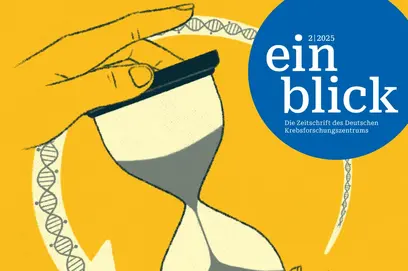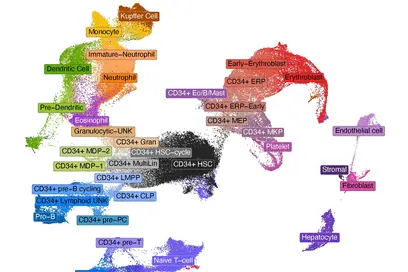Um herauszufinden, welche weiteren Bausteine im Wnt-Signalweg eine Rolle spielen, untersuchten die Wissenschaftler um Christof Niehrs aus der Abteilung Molekulare Embryologie menschliche Nierenzellen. In diese schleusten sie das Luciferase-Gen ein, das immer dann ein Leuchtsignal abgab, wenn der Wnt-Signalweg durch die Zugabe von Wnt aktiviert wurde. Anschließend blockierten sie in Zusammenarbeit mit Kollegen um Michael Boutros aus der Abteilung Signalwege und Funktionelle Genomik in einem „Gesamt-Genom“-Ansatz nacheinander insgesamt 18500 Gene durch die Zugabe kleiner RNA-Moleküle, so genannter „small interfering RNAs“. In den Zellen, die anschließend bei Zugabe von Wnt nicht mehr leuchteten, war offenbar ein entscheidendes Gen des Wnt-Signalweges ausgeschaltet worden.
Als die Wissenschaftler die Zellen, die nicht mehr leuchteten, näher analysierten, stießen sie auf zwei „alte Bekannte“: Zum einen den „Prorenin-Rezeptor“, der das Signal des Bluthochdruck-Hormons Renin vermittelt. Kinder, die Mutationen an diesem Rezeptor aufweisen, sind häufig geistig behindert oder leiden an Epilepsie. Offenbar vermittelt dieser Rezeptor gemeinsam mit dem Wnt-Rezeptor auch das Wnt-Signal. Für eine weitere Überraschung sorgte die Entdeckung, dass eine „Protonenpumpe“, die in zellulären Organellen für ein saures Milieu sorgt, offenbar notwendig ist, um das Wnt-Signal zu übermitteln. Es ist bekannt, dass diese Pumpe bei verschiedenen Prozessen eine Rolle spielt, etwa beim Eintritt von Viren in die Zelle, bei der Entstehung von Metastasen bei Krebs oder bei der Bildung der Rechts-Links-Achse während der Embryonalentwicklung. In vielen Organismen führt das Fehlen dieser Pumpe zum frühen Absterben.
„Unsere Resultate werfen weitere Fragen auf“, blickt Christof Niehrs in die Zukunft, „etwa, welche Rolle der Prorenin-Rezeptor bei geistiger Behinderung spielt. Und die Protonenpumpe könnte ein lohnendes Ziel für eine Therapie sein, etwa um bei Krebserkrankungen in den Wnt-Signalweg gezielt einzugreifen.“
Ein Bild steht zur Pressemitteilung steht im Internet zur Verfügung unter:
www.dkfz.de/de/presse/pressemitteilungen/2010/images/Fresh_Yellow_Lemon.jpg
Requirement of prorenin receptor and vacuolar H+-ATPase-mediated acidification for Wnt signaling.
Cruciat CM, Ohkawara B, Acebron SP, Karaulanov E, Reinhard C, Ingelfinger D, Boutros M, Niehrs C.
Science. 2010 Jan 22;327(5964):459-63. DOI: 10.1126/science.1179802
Über das DKFZ
Das Deutsche Krebsforschungszentrum (DKFZ) ist mit mehr als 3.000 Mitarbeiterinnen und Mitarbeitern die größte biomedizinische Forschungseinrichtung in Deutschland. Wissenschaftlerinnen und Wissenschaftler erforschen im DKFZ, wie Krebs entsteht, erfassen Krebsrisikofaktoren und suchen nach neuen Strategien, die verhindern, dass Menschen an Krebs erkranken. Sie entwickeln neue Methoden, mit denen Tumoren präziser diagnostiziert und Krebspatienten erfolgreicher behandelt werden können. Beim Krebsinformationsdienst (KID) des DKFZ erhalten Betroffene, Interessierte und Fachkreise individuelle Antworten auf alle Fragen zum Thema Krebs.
Um vielversprechende Ansätze aus der Krebsforschung in die Klinik zu übertragen und so die Chancen von Patientinnen und Patienten zu verbessern, betreibt das DKFZ gemeinsam mit exzellenten Universitätskliniken und Forschungseinrichtungen in ganz Deutschland Translationszentren:
- Nationales Centrum für Tumorerkrankungen (NCT, 6 Standorte)
- Deutsches Konsortium für Translationale Krebsforschung (DKTK, 8 Standorte)
- Hopp-Kindertumorzentrum (KiTZ) Heidelberg
- Helmholtz-Institut für translationale Onkologie (HI-TRON) Mainz – ein Helmholtz-Institut des DKFZ
- DKFZ-Hector Krebsinstitut an der Universitätsmedizin Mannheim
- Nationales Krebspräventionszentrum (gemeinsam mit der Deutschen Krebshilfe)
Das DKFZ wird zu 90 Prozent vom Bundesministerium für Forschung, Technologie und Raumfahrt und zu 10 Prozent vom Land Baden-Württemberg finanziert und ist Mitglied in der Helmholtz-Gemeinschaft Deutscher Forschungszentren.



